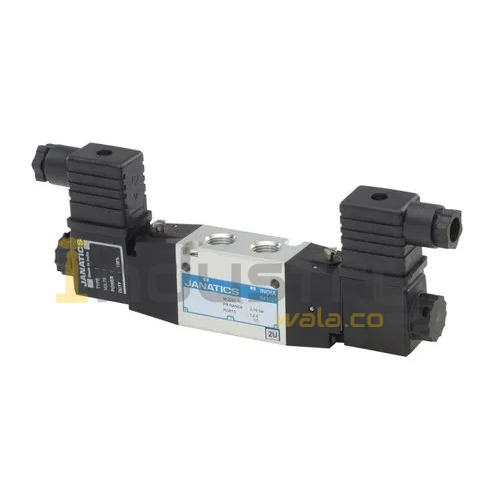- Shop all catagories
- Automated Valves
- Gauges & accessories
- Hydraulics
- Pneumatics
- Water Meters
- Manual Valves
- IBR Certified Boiler Valves
- Non IBR Boiler Valves
- Pipe Fittings & Flanges
Janatics DS255SS61 Double Solenoid Valve 5/2 Way 1/4″
₹2,420
Brand : Janatics
Model : DS255SS61
Pressure : Upto 10KG/CM2
Temperature : Upto 80C
Media : Compressed Air
Product Information
Description
Additional information
Reviews
Description
What is a Double Solenoid valve?
The definition of a solenoid valve is an electro-mechanical valve that is commonly employed to control the flow of liquid or gas. There are various solenoid valve types, but the main variants are either pilot operated or direct acting. Pilot operated valves, the most widely used, utilise system line pressure to open and close the main orifice in the valve body. While Direct operated solenoid valves directly open or close the main valve orifice, which is the only flow path in the valve. They are used in systems requiring low flow capacities or applications with low pressure differential across the valve orifice.Double Solenoid valve or Directional Control Valve – How They Work
The double solenoid valve features the three-position valve. When there are no signals, the double solenoid valve stays at the middle, and the piston moves to the piston with signals and pipeline breakover is realized. After disconnection with power, the piston resumes to the middle position. The double solenoid valve is just like the double-acting pneumatic cylinder, which has no spring resetting. The two coils just have one excitation and adopts the working mode of one pushing and the other pulling. Directional control valves are used in pneumatic systems to direct or stop the flow of compressed air or oil to their appliances. They are probably the most used elements in pneumatic systems and can be used for example to actuate a cylinder, a larger industrial valve, or air tools. The valves can have two or more ports and fulfill various circuit functions. The function and behavior of the valve can be indicated by a symbol. The symbol however doesnt explain the construction of the valve. Directional control valves can be actuated by different means, such as manual actuation or solenoid actuation.5/2-way valve
A 5/2-way valve has five ports and two states. These valves are used for instance to control double acting cylinders. A double acting cylinder requires two outlet ports of the valve. 5/2-way valves can be mono-stable or bi-stable.5/3-way valve
The before mentioned valves all have two states. It is also possible to have a third state, for example, a 5/3-way solenoid valve. The third state is used to stop a double acting cylinder in an intermediate position. These valves are mono stable and return to the center position when the solenoids are not energized. Two solenoids are used to switch the valve to the other two states. 5/3 valves are available in three variants; with closed center position, with venting center position and with the pressurized center position. Link to more direction control valves Watch how Double solenoid valve works.Additional information
Reviews










